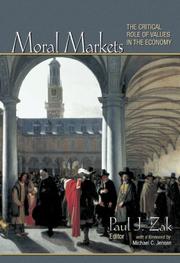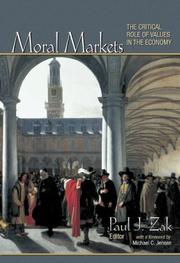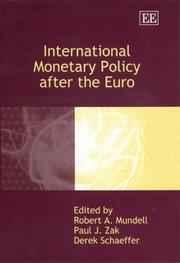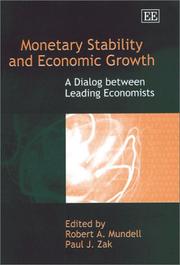| Listing 1 - 10 of 11 | << page >> |
Sort by
|

ISBN: 1840640480 9781840640489 Year: 1999 Publisher: Cheltenham: Elgar,
Abstract | Keywords | Export | Availability | Bookmark
 Loading...
Loading...Choose an application
- Reference Manager
- EndNote
- RefWorks (Direct export to RefWorks)
Money. Monetary policy --- International finance --- Financial crises --- Monetary policy --- Monetary unions --- Congresses --- 339.732 --- 336.741 --- -International finance --- -Monetary policy --- -Monetary unions --- -AA / International- internationaal --- 333.80 --- 333.431 --- 333.481 --- NBB congres --- -Financial crises --- -332.46 --- Crashes, Financial --- Crises, Financial --- Financial crashes --- Financial panics --- Panics (Finance) --- Stock exchange crashes --- Stock market panics --- Crises --- Business cycles --- International monetary system --- International money --- Finance --- International economic relations --- Common currencies --- Currency areas --- Currency unions --- Optimum currency areas --- Currency question --- Money --- Monetary management --- Economic policy --- Currency boards --- Money supply --- Internationale banken. Wereldbank. Ontwikkelingsbank. Investeringsbank. Comecom, samenwerkingsbank. Europees monetair fonds. Europees ontwikkelingsfonds. Europese investeringsbank. Europese monetaire --- Origin and nature of money --- Geld-, bank- en kredietpolitiek. Kapitaalmarkt en -rente: algemeenheden. --- Monetaire Unies. --- Monetaire crisissen, hervormingen, saneringen en stabilisering. --- 336.741 Origin and nature of money --- 339.732 Ida. Ibrd. Bird. Ifc. Imf. Speciale trekkingsrechten. Bank voor internationale betalingen. Internationaal monetair systeem --- 339.732 Internationale banken. Wereldbank. Ontwikkelingsbank. Investeringsbank. Comecom, samenwerkingsbank. Europees monetair fonds. Europees ontwikkelingsfonds. Europese investeringsbank. Europese monetaire --- Ida. Ibrd. Bird. Ifc. Imf. Speciale trekkingsrechten. Bank voor internationale betalingen. Internationaal monetair systeem --- 332.46 --- AA / International- internationaal --- Monetaire Unies --- Monetaire crisissen, hervormingen, saneringen en stabilisering --- Geld-, bank- en kredietpolitiek. Kapitaalmarkt en -rente: algemeenheden --- International finance - Congresses --- Financial crises - Congresses --- Monetary policy - Congresses --- Monetary unions - Congresses

ISBN: 9780691135236 9780691135229 0691135223 0691135231 Year: 2008 Publisher: Princeton Princeton University Press
Abstract | Keywords | Export | Availability | Bookmark
 Loading...
Loading...Choose an application
- Reference Manager
- EndNote
- RefWorks (Direct export to RefWorks)
LI, 344 p.
Economics --- Moral and ethical aspects --- 174 --- bedrijven, ethiek --- AA / International- internationaal --- Economic theory --- Political economy --- Verband tussen de ethiek en de economie. Ethiek en bedrijf --- Social sciences --- Economic man --- Economie --- Waarden --- Ethiek --- Managementethiek --- Waarde (ethiek) --- Ondernemingsethiek --- Godsdienst --- Sport --- Duurzaamheid --- Filosofie --- Psychologie --- Sociologie --- Man --- Cultuur --- Erfelijkheidsleer --- Stadssamenleving --- Technologie --- Voeding --- Maatschappij --- Verpleegkunde --- Drank --- Gezondheid --- Volwassene

ISBN: 1400837367 9786612964626 1282964623 0691135223 0691135231 9781400837366 9780691135229 9780691135236 6612964626 9781282964624 Year: 2008 Publisher: Princeton : Princeton University Press,
Abstract | Keywords | Export | Availability | Bookmark
 Loading...
Loading...Choose an application
- Reference Manager
- EndNote
- RefWorks (Direct export to RefWorks)
Drawing on converging evidence from neuroscience, social science, biology, law, and philosophy, Moral Markets makes the case that modern market exchange works only because most people, most of the time, act virtuously. --from publisher description.
Economics --- Moral and ethical aspects. --- Economic theory --- Political economy --- Social sciences --- Economic man --- Economics - Moral and ethical aspects
Book
ISBN: 9780593067499 0593067495 9780593067505 0593067509 Year: 2012 Publisher: London : Bantam Press,
Abstract | Keywords | Export | Availability | Bookmark
 Loading...
Loading...Choose an application
- Reference Manager
- EndNote
- RefWorks (Direct export to RefWorks)
Oxytocin --- Trust. --- Cooperation. --- Psychophysiology. --- Moral and ethical aspects.
Book
ISBN: 9780814437667 Year: 2017 Publisher: New York AMACOM
Abstract | Keywords | Export | Availability | Bookmark
 Loading...
Loading...Choose an application
- Reference Manager
- EndNote
- RefWorks (Direct export to RefWorks)
For decades, alarms have sounded about declining engagement. Yet companies continue to struggle with toxic cultures, and the low productivity and unhappiness that go with them. Why is culture so difficult to improve? What makes so many good employees check out? Neuroscientist Paul Zak shows that innate brain functions hold the answers. It all boils down to trust. When someone shows you trust, a feel-good jolt of oxytocin surges through your brain and triggers you to reciprocate. This simple mechanism creates a perpetual trust-building cycle--the key to changing stubborn workplace patterns. Drawing on his original research, Zak teases out science-backed insights for building high-trust organizations. Trust Factor opens a window on how brain chemicals affect behavior, why trust gets squashed, and ways to consciously stimulate it by celebrating effort, sharing information, promoting ownership, and more. The Ofactor(TM) survey, data, and examples support the action plans. Engagement programs and monetary rewards are Band-Aids on broken bones. To get to the root of the problem, you've got to go deeper. Packed with examples from The Container Store, Zappos, and Herman Miller, Trust Factor harnesses our neurochemistry to effectively cultivate work places where trust, joy, and commitment compound naturally.
Sociology of work --- arbeidsmotivatie --- motivatie --- organisatiemanagement --- neurowetenschappen --- HRM (human resource management) --- organisatiecultuur
Book
ISBN: 9780814437674 0814437672 Year: 2017 Publisher: New York : AMACOM, American Management Association,
Abstract | Keywords | Export | Availability | Bookmark
 Loading...
Loading...Choose an application
- Reference Manager
- EndNote
- RefWorks (Direct export to RefWorks)
For decades, alarms have sounded about declining engagement. Yet companies continue to struggle with toxic cultures, and the low productivity and unhappiness that go with them. Why is “culture” so difficult to improve? What makes so many good employees check out? Neuroscientist Paul Zak shows that innate brain functions hold the answers. It all boils down to trust. When someone shows you trust, a feel-good jolt of oxytocin surges through your brain and triggers you to reciprocate. This simple mechanism creates a perpetual trust-building cycle—the key to changing stubborn workplace patterns. Drawing on his original research, Zak teases out science-backed insights for building high-trust organizations. Trust Factor opens a window on how brain chemicals affect behavior, why trust gets squashed, and ways to consciously stimulate it by celebrating effort, sharing information, promoting ownership, and more. The Ofactor™ survey, data, and examples support the action plans. Engagement programs and monetary rewards are Band-Aids on broken bones. To get to the root of the problem, you’ve got to go deeper. Packed with examples from The Container Store, Zappos, and Herman Miller, Trust Factor harnesses our neurochemistry to effectively cultivate work places where trust, joy, and commitment compound naturally.
Corporate culture. --- Trust. --- Performance. --- Organizational effectiveness. --- Organizational behavior.

ISBN: 1845421213 Year: 2005 Publisher: Cheltenham Edward Elgar
Abstract | Keywords | Export | Availability | Bookmark
 Loading...
Loading...Choose an application
- Reference Manager
- EndNote
- RefWorks (Direct export to RefWorks)
Euro --- Eurozone --- International finance --- Monetary policy

ISBN: 1840649984 Year: 2002 Publisher: Cheltenham Edward Elgar
Abstract | Keywords | Export | Availability | Bookmark
 Loading...
Loading...Choose an application
- Reference Manager
- EndNote
- RefWorks (Direct export to RefWorks)
Book
Year: 1997 Publisher: Cambridge, Mass. National Bureau of Economic Research
Abstract | Keywords | Export | Availability | Bookmark
 Loading...
Loading...Choose an application
- Reference Manager
- EndNote
- RefWorks (Direct export to RefWorks)
We analyze the dynamics of a simple growth model in which production occurs with a delay while new capital is installed (time-to-build). The time-to-build technology is shown to yield a system of functional (delay) differential equations with a unique steady state. We demonstrate that the steady state, though typically a saddle, may exhibit Hopf cycles on a measurable set of the parameter space. Furthermore, the optimal path to the steady state is oscillatory. A counter-example to the claim that intrinsically oscillatory on the central technical apparatus the mathematics of functional differential equations.


ISBN: 9781400837366 9780691135236 Year: 2010 Publisher: Princeton, N.J. Princeton University Press
Abstract | Keywords | Export | Availability | Bookmark
 Loading...
Loading...Choose an application
- Reference Manager
- EndNote
- RefWorks (Direct export to RefWorks)
| Listing 1 - 10 of 11 | << page >> |
Sort by
|

 Search
Search Feedback
Feedback About UniCat
About UniCat  Help
Help News
News